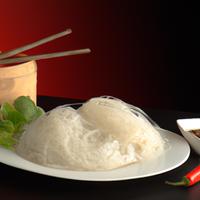
1 serving (100 grams) contains 351 calories, 0.1 grams of protein, 0.1 grams of fat, and 86.0 grams of carbohydrates.

Log this food in SnapCalorie

Nutrition Information
Calories |
702 | ||
|---|---|---|---|
% Daily Value* |
|||
| Total Fat | 0.2 g | 0% | |
| Saturated Fat | 0 g | 0% | |
| Polyunsaturated Fat | 0 g | ||
| Cholesterol | 0 mg | 0% | |
| Sodium | 20 mg | 0% | |
| Total Carbohydrates | 172 g | 62% | |
| Dietary Fiber | 1 g | 3% | |
| Sugars | 0 g | ||
| protein | 0.2 g | 0% | |
| Vitamin D | 0 mcg | 0% | |
| Calcium | 20 mg | 1% | |
| Iron | 1 mg | 5% | |
| Potassium | 20 mg | 0% | |
* Percent Daily Values are based on a 2,000 calorie diet. Your daily values may be higher or lower depending on your calorie needs.
Food Attributes
Source of Calories
About Chinese vermicelli
Chinese vermicelli, also known as cellophane noodles or glass noodles, is a type of translucent noodle commonly used in Chinese cuisine and across Asia. Made from starches such as mung bean, sweet potato, or rice, this noodle has a silky texture and is often featured in stir-fries, soups, and spring rolls. Naturally gluten-free, it serves as a versatile option for people with dietary restrictions. While low in fat and cholesterol, Chinese vermicelli is primarily a source of carbohydrates and offers little protein, fiber, or micronutrients. Its neutral flavor absorbs sauces and seasonings well, making it a staple in flavorful dishes. When enjoying vermicelli, be mindful of portion sizes and the overall nutritional profile of the dish, as accompaniments like oils, sauces, or high-sodium broths can significantly impact its healthfulness.



